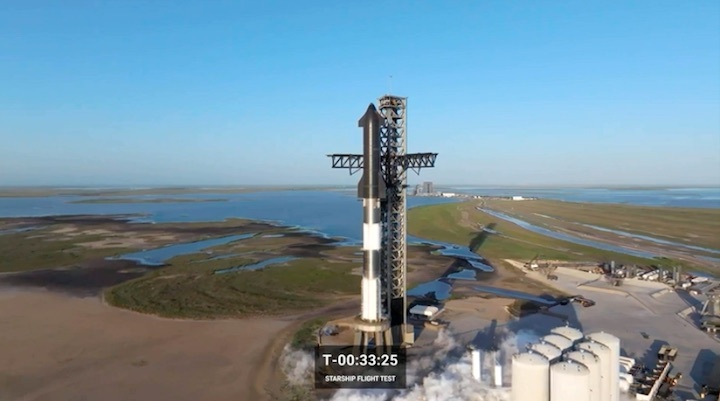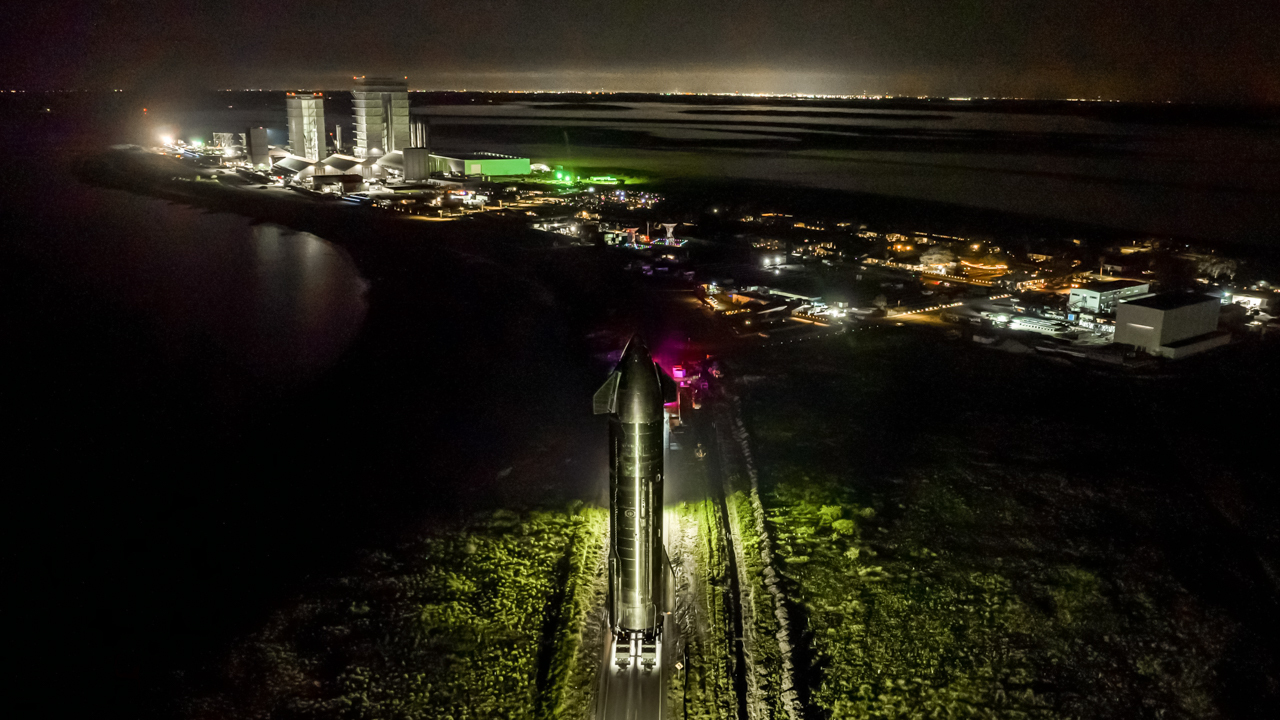23.04.2023
SpaceX urges finders to report debris from first Starship test flight
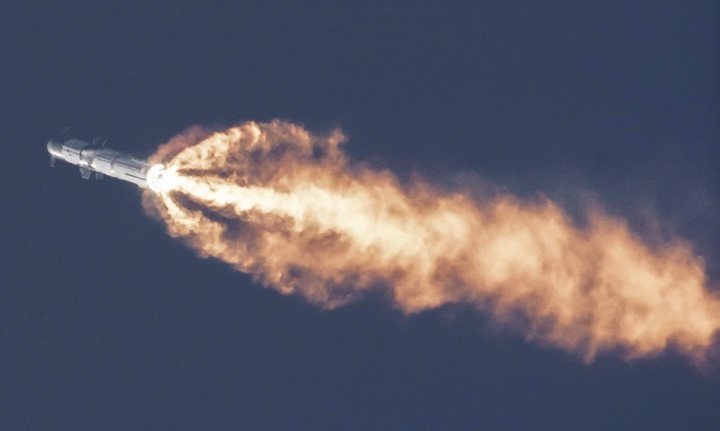
SpaceX's first fully-integrated Starship and Super Heavy rocket flies spaceward before entering a tumble and then being commanded to explode over the Gulf of Mexico on April 20, 2023. (SpaceX)
Hours after the first test flight of SpaceX's Starship ended with the spacecraft and its Super Heavy booster tumbling until it was commanded to explode, possible debris from the colossal rocket began to wash up on the shores surrounding the company's Starbase launch facility in Boca Chica, Texas.
Local county officials were quick to order temporary road and beach closures to aid in "anomaly clean-up efforts," but given that the vehicle was well over the Gulf of Mexico and reached an altitude of approximately 25 miles (40 kilometers) before it broke apart on Thursday (April 20), the precautions only extended to a relatively small area of where fragments of the world's tallest and most powerful rocket could end up.
"Look what I found!" posted Joe Tegtmeyer to Twitter at 6:30 p.m. CDT (2300 GMT), about nine hours after the Starship launch, captioning photos of himself holding up what appeared to be roughly a half of one of the 18,000 hexagonal heat shield tiles that covered one side of the Starship. Had stage separation not failed, Starship may have used the tile and others like it to protect against the tremendous heat of reentry as it fell back through Earth's atmosphere above the Pacific Ocean off the coast of Hawaii.
"Not sure when it departed the ship, but I would suspect more will wash ashore over the next few days," wrote Tegtmeyer, who describes himself as "interested in all things space related, SpaceX." Tegtmeyer could not rule out, though, that the tile was from an earlier test. Although this was the first time Starship and Super Heavy had flown together, SpaceX has previously flown and lost Starship vehicles on "hops" as the company worked to perfect recovering the spacecraft.
Tegtmeyer was not the only person to find a possible piece of a Starship. Photos shared on social media showed that at least one other person had come across a smaller fragment of the black and white ceramic tiles.
For its part, SpaceX issued an advisory to the public, warning against attempting to handle or retrieve the debris directly. Instead, the company invites finds be reported to its hotline at 1-866-623-0234 or emailed to recovery@spacex.com.
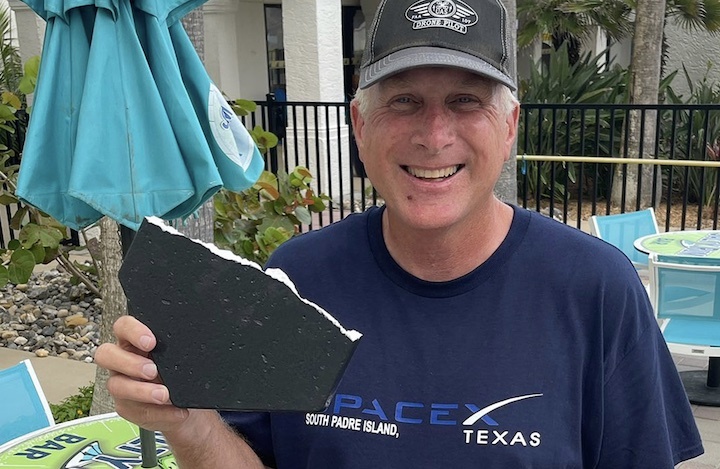
Joe Tegtmeyer holds up a possible heat shield tile from the first test flight of SpaceX's Starship and Super Heavy launch vehicle on April 20, 2023. The fragment was found on South Padre Island Beach, about seven miles from where Starship launched. (Joe Tegtmeyer)
"Teams are actively monitoring both message boxes and will ensure the notification is handled appropriately. We are unable to respond to every message received, but our teams will reach out as appropriate," SpaceX officials wrote. "If you have concerns about an immediate hazard, please contact your local law enforcement agency."
Though the Starship test flight was a privately-funded activity, it was conducted under a Federal Aviation Administration (FAA) launch license asserting it was being undertaken with the oversight of the United States. As a party to the Outer Space Treaty of 1967, protections are extended that any spacecraft components found anywhere on Earth (or in space) remain the property of the launch operatoruntil such time that the entity explicitly relinquishes them.
As such, all of the Starship debris remains SpaceX's property, even if it is found on private property or in the Gulf of Mexico.
Tegtmeyer said he respected the rules regarding his find.
"I'm in contact with SpaceX and provided the geolocation of where I found it," he said. "They responded thanking me for the info."
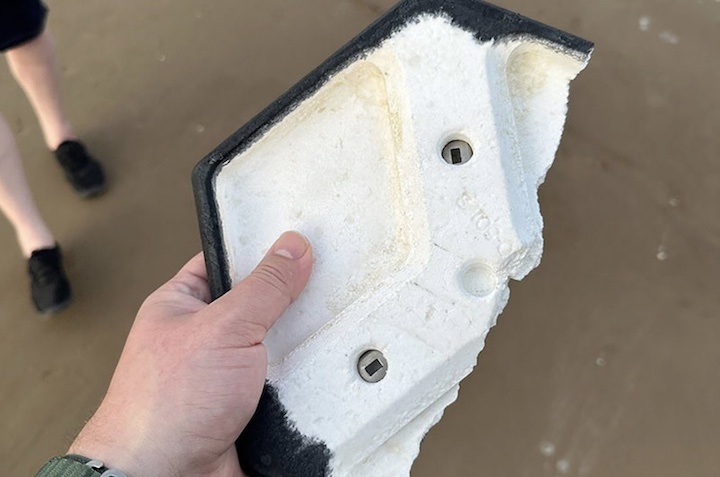
Joe Tegtmeyer displays the underside of the ceramic tile that he found on South Padre Island Beach in Texas on Thursday, April 20, 2023, later on the same day that SpaceX launched 18,000 similar tiles on its first Starship and Super Heavy test flight from nearby Boca Chica. (Joe Tegtmeyer)
Quelle: CS
+++
Starship Orbital Test Flight Raises Serious Questions
Yesterday, April 20 at 8:33 CST, SpaceX attempted its first orbital launch of the Starship (S24) and Super Heavy Booster (B7). Starship succeeded in clearing the launch tower and surviving through MaxQ, or maximum dynamic pressure, but was terminated 4 minutes after launch.
Starship 24 was the first orbital prototype and Booster 7 was the first SH Booster to have all 33 Raptor engines.
As Starship cleared the tower, the first sign of trouble was that 3 out the Super Heavy Booster’s 33 engines had already failed. The failure of 3 Raptor engines before lift-off would have ended the launch of most rockets (Delta, Atlas, SLS, Falcon 9), which are only released from the launchpad when all systems are nominal. The loss of three engines before lift-off is not considered nominal or safe.
From there, things seemed to go well for the next 25 seconds, at which point something unexpected appeared to happen at the base of the Super Heavy Booster.
At 0:29, and within approximately a couple of seconds, an explosion occurred at the Super Heavy Booster’s base. Some have speculated that it was a hydraulic power unit (HPU)? It also appeared that part of the booster’s cladding appeared to be ejected by the force of the event.
Within a minute into the launch, another 3 engines had failed, for a total of 6 engines out. Unknown at this time is whether the additional Raptor engine failures are due to possible issues with the Raptor engines themselves or that the engines were damaged by debris from launch.

At 2:40, moments before main engine cut-off and staging for Starship, Super Heavy Booster began its arc to orient itself for Starship staging. However, the arc continued into a loop. The booster’s guidance and control (G&C) system did not seem to accept this as a failure of guidance laws. The booster completed over 3 loop de loops over the course of 1 minute and 19 seconds after which the flight termination system (FTS) engaged at 3:59. Failure of the flight termination system to terminate the launch after explosions at the base of the Super Heavy Booster or the booster doing multiple aerial acrobatics is likely something that will need to be resolved before another launch is allowed.
Starship, the launch abort system for the Starship Super Heavy Booster stack, never engaged as Super Booster tumbled over 3 times. There is some photographic evidence that Starship was partially separated from the Super Heavy Booster, but that was likely due to affects from the booster looping during the last 1 minute 19 seconds of its flight.
For over the past three years, there have been worries expressed that the Starship launch pad did not have any of the systems used by NASA and others to diminish the energy of a launch such as a flame trench, flame deflector, and water deluge system. The lack of those energy absorption systems seems to have had a severe affect on the launchpad.
Post launch, it became apparent that erosion at the launchpad area was extensive. A crater several feet deep was gouged out nearly to the width of the Starship launch stand. Concrete panels surrounding the launchpad were gone. There was extensive damage to facilities at the Starship base, including a liquid oxygen tank that was heavily dented.
Debris and chunks of concrete were ejected for up to several hundred yards from the launchpad.
The impact was not just ballistic but also of high speed trajectories that destroyed cars parked over 200 yards away.
After the dust had settled, there appeared to be chunks of concrete strewn across the launch area.
Smaller debris made it all the way to Port Isabel, 5 miles away.
Starship’s first orbital test flight did see successes. Starship cleared the tower and it did make it through maximum dynamic pressure, two significant accomplishments that will feed good data back to SpaceX.
The launch to orbit of SpaceX’s first orbital Starship test flight show several events during the mission that SpaceX and NASA likely will want to remedy before another launch attempt.
NASA in particular is left with some hard choices arising from choosing Starship as its sole lunar lander for the Artemis III mission. There is little question that the schedule for the Starship lunar lander, which was running already a little bit behind, will now be pushed significantly to the right. The test flight of a “skeleton” Starship lunar landing is unlikely to occur in 2024, as planned. There were never plans to test the Starship lunar lander with a crew in Earth orbit, as NASA did with its Lunar Module in Apollo 9, or in lunar orbit, as in Apollo 10. Instead, after the lunar landing test in 2024, the next flight of the Starship lunar lander would occur on Artemis III with a crew.
The lack of proper energy absorption and dampening around the launchpad resulting in destruction of the underlying concrete, ejection of that concrete and underlying soil, resulting in gouging of a large crater under the launchpad means a lot of infrastructure work before the next launch. Some of that work may, likely will, require additional federal government participation.
That the booster was allowed to lift-off without all of its engines working is unusual in today’s launch environment. Since the 1940’s, possibly earlier, launch vehicles have not been released to fly unless all of their engines are working. The reason is simple; if the engines are not working as planned after ignition, there is already a significant problem that could only get worse if the vehicle is unleashed.
The failure of the booster’s guidance & control to detect that the booster was off its normal ascent trajectory, that it was looping during its ascent, and to terminate the flight for a full 1 m 19 s that the booster performed over 3 loop de loops is another issue that will have to be addressed. Such a delay in the flight termination system could have catastrophic consequences. For example, Port Isabel is only 5 miles away from Starbase, a distance that could be covered by a launching Starship in a tiny fraction of the 1 minute and 19 seconds that it took the FTS to finally activate.
More critically for the aspirations of future crewed flight is the failure of the Starship, the launch abort system for the Starship stack, to abort when the booster experienced issues during ascent or when the booster went off its nominal trajectory. Whether this was due to the booster’s own systems not detecting an issue or with Starship remains to be determined.
Whether the Starship test flight failure will force a delay in the launch of Artemis III depends on whether the Artemis III mission itself is already delayed so much that a delay in Starship is meaningless. NASA has no Plan B to the Starship lunar lander. For the first time in American spaceflight history, the goals of the space program, in the case of Artemis III to land astronauts once again on the Moon’s surface, are hitched to the progress of a single space company over which NASA has little or no control.
It is worth reminding that the Starship lunar lander has no descent abort capability. That means that should anything critical go wrong on the Starship lander during descent to the lunar surface, the crew would be forced to wait for its Newtonian-determined end. Anyone thinking NASA is not capable of taking risks certainly doesn’t appreciate the unprecedented risks it is taking in getting the Artemis III crew to the lunar surface over 339,000 miles away.
Later on April 20, SpaceX released the following statement:
Starship gave us quite a show during today’s first flight test of a fully integrated Starship and Super Heavy rocket from Starbase in Texas.
At 8:33 a.m. CT, Starship successfully lifted off from the orbital launch pad for the first time. The vehicle cleared the pad and beach as Starship climbed to an apogee of -39 km over the Gulf of Mexico – the highest of any Starship to-date. The vehicle experienced multiple engines out during the flight test, lost altitude, and began to tumble. The flight termination system was commanded on both the booster and ship. As is standard procedure, the pad and surrounding area was cleared well in advance of the test, and we expect the road and beach near the pad to remain closed until tomorrow.
With a test like this, success comes from what we learn, and we learned a tremendous amount about the vehicle and ground systems today that will help us improve on future flights of Starship. Thank you to our customers, Cameron County, and the wider community for the continued support and encouragement. And congratulations to the entire Space team on an exciting first flight test of
Starship!
Quelle: AS
----
Update: 24.04.2023
.
Here's what caused the SpaceX Starship explosion and how it's different for Florida
Shortly after SpaceX's massive Starship launched from Texas on its first full test early Thursday, the 400-foot stack of hardware began to tumble until it broke apart in a fiery explosion over the Gulf of Mexico.
The overall demonstration mission – a test of the new rocket's ability to ignite and clear the pad's 500-foot tower – was successful. At liftoff, however, several of the rocket's 33 Raptor engines failed to fire up as planned. Then came the more than minute-long tumble at roughly three minutes into flight, which kicked off just after the rocket's Starship upper stage and Super Heavy booster failed to separate.
Some experts and spectators were left wondering if the test flight's explosive conclusion was the result of aerodynamic forces shearing the vehicle apart or if it was purposefully blown up by the flight termination system, or FTS. SpaceX did later confirm the rocket's breakup was triggered by FTS.
Flight termination systems are essentially explosives built into key areas of rockets and are, at least on newer vehicles, automatically triggered if a hardware failure is detected. They're a safety and licensing requirement and are especially important if a rocket appears to veer off course.
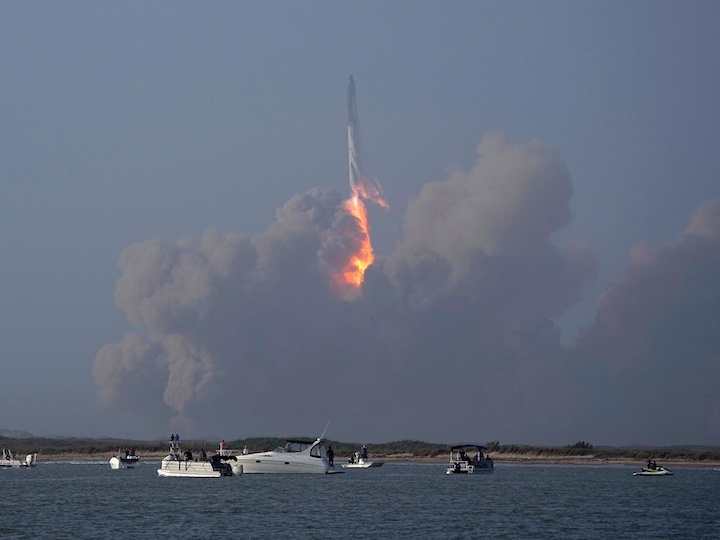
But Thursday's launch from Starbase, a SpaceX-operated facility near Brownsville, Texas, was unique. Not only was it a test flight of a brand new vehicle, meaning slightly different parameters for termination, but it also flew from an area entirely new to launching orbital missions — previous Starship test flights ended explosively, but did not attempt to reach high altitudes. A launch of the same magnitude from Florida might have had stricter parameters meaning the rocket wouldn't have been allowed to tumble as long, for example.
"Every range has what's called impact limit lines," Mike Leinbach, NASA's former space shuttle launch director, told FLORIDA TODAY. "That's the theoretical limit that the vehicle can fly within. They're boundaries projected on a map that if the vehicle goes out of those boundaries, the flight termination system kicks in."
Why Flight Termination Systems are used
In Florida, the Eastern Range — Cape Canaveral Space Force Station and Kennedy Space Center — is overseen by the Space Force's Space Launch Delta 45, which is also partially responsible for certifying termination systems. At SpaceX's facility in Texas, however, there is no Space Force presence there, so the Federal Aviation Administration plays a larger role.
Abhi Tripathi, director of mission operations at the University of California, Berkeley's Space Sciences Laboratory, said there are many reasons why a rocket's termination system is triggered: loss of thrust, unplanned acceleration, failures with certain components, off-course trajectories, and more.
"I'm venturing to guess it already didn't have enough thrust even before FTS kicked in because, like everyone else, I could see several engines were out. So at that point, some software trigger also said, 'Sorry, don't have enough juice to get to space anymore' and FTS kicked in," Tripathi said.
Starship's auto-destruct triggers likely would have been different for the Texas-based liftoff in comparison to more commonly seen Falcon 9 launches from Florida. Tripathi said if Starship had launched from Kennedy Space Center instead, the triggers likely would have been modified to fit an already existing system like Falcon 9.
"I would assume the triggers would be entirely consistent with Falcon 9's (SpaceX's workhorse rocket) triggers ... in terms of the narrowness of the corridor and other related things," Tripathi said.
Sometimes termination is intentional as SpaceX showed
Pasts incidents involving FTS are few and far between, but it's a potential factor during every launch. One of the more recent, high-profile incidents involving FTS was actually intentional: in January 2020, SpaceX purposefully simulated the loss of a Falcon 9 rocket to test an uncrewed Crew Dragon capsule's escape system performance. The mock emergency saw the capsule successfully detect an anomaly, then rapidly propel away from the exploding rocket below — a move that would have saved astronaut lives had they been on board.
Another factor when it comes to Florida launches is population and development. During NASA's first launch of the Space Launch System rocket from pad 39B in November 2022, for example, the rocket's flight termination system was a big topic of discussion: what if it had to be triggered shortly after liftoff, sending debris raining down over the Atlantic Ocean?
Fortunately, that did not come to pass as the Artemis I mission was successful, but SLS was also a big rocket. The bigger the the vehicle, the bigger the potential for damages should things go wrong.
At KSC, meanwhile, SpaceX is still targeting no earlier than the evening of Wednesday, April 26, for its next launch: a three-core Falcon Heavy. The 230-foot rocket will fly from pad 39A with a communications satellite around 7:30 p.m. EDT, but the mission won't include the usual side booster landings at Cape Canaveral. The rocket's center core also won't be recovered after liftoff due to the weight and destination of the satellite.
Quelle: Florida Today
----
Update: 4.05.2023
.
SpaceX should be ready to launch Starship again in 6 to 8 weeks, Elon Musk says
The billionaire entrepreneur went on to say that the launch pad and the next Starship vehicle should be ready to launch in six to eight weeks. The next mission will have the same basic goal as the first — get Starship's 165-foot-tall (50 meters) upper stage partway around Earth, and bring it down near Hawaii.
Technical readiness is only part of the picture, however. SpaceX will also have to secure another launch license from the U.S Federal Aviation Administration, which is currently investigating, along with SpaceX, exactly what happened on the April 20 launch.
That investigation is likely looking into Starship's FTS, because the system didn't work exactly as planned during the debut launch: A whopping 40 seconds elapsed between the issuing of the self-destruct command and the explosion high above the Gulf of Mexico, Musk said.
"The longest-lead item is probably requalification of the flight termination system," Musk said during Saturday's Twitter Spaces talk. "That's obviously something that we want to make sure of before proceeding with the next flight."
Quelle:SC
----
Update: 20.05.2023
.
SpaceX rolls next Starship prototype out to pad for engine test (photo)

